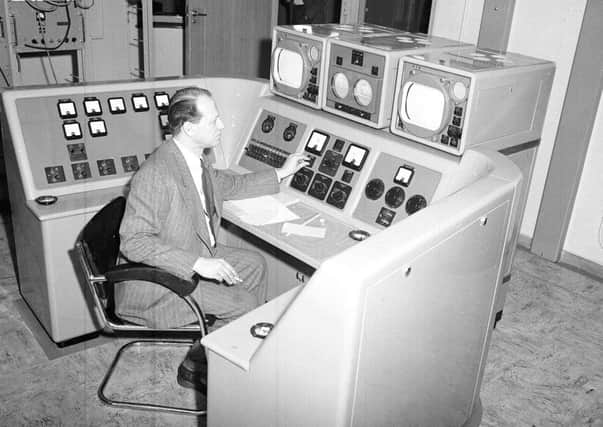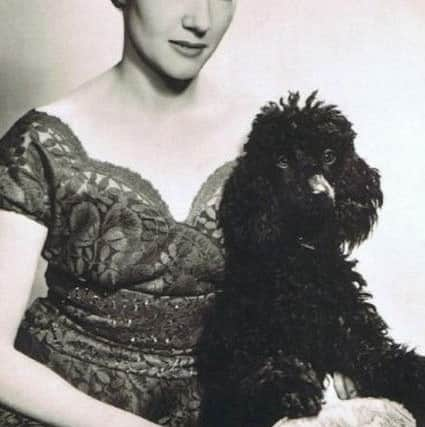When Scotland went quiet for the nation's first TV broadcast


In Perth, patients and nurses watched together at the county sanitorium on a hill outside the city and at Aberdeen, Peterhead and Pitlochry, viewers struggled with reception.
At 7.30pm on March 14 1952, Scotland fell quiet as the country’s first television broadcast, live and direct from Studio 1 in Queen Street, Edinburgh, was beamed across the UK 65 years ago this month following the switch on of the Kirk O’ Shotts transmitting station.
Advertisement
Hide AdAdvertisement
Hide AdAmid a nationwide hush, the first pictures to come on screen were the BBC logo and a view of Big Ben and The Thames.


Continuity presenter Mary Malcolm introduced Alastair Macintyre, chief TV announcer for Scotland - and the show was underway.
A speech by James Stuart, secretary of State for Scotland, a prayer and an address from the Lord Provost of Edinburgh got the programme off to a rather muted start but the show picked up a pace with a live performance from the Edinburgh branch of the Royal Scottish Country Dance Society.
To the sound of Tim Wright’s Band, the eight members danced The Duke and Duchess of Edinburgh and Rouken Glen, with the performance impressing with a “smooth and stately rhythm and old graciousness,” according to reports.
At the public screenings in Glasgow, people wrestled for a view.


A report in the Glasgow Herald the following morning said: “In Parkhead, there were new queues - for TV, not for football.
“Before the first 300 had seen even the opening minute of the programme there was another queue of 300 outside the door waiting for the second half-hour show.
Advertisement
Hide AdAdvertisement
Hide Ad“There was some queue jumping when the first 300 were asked to leave.”
Mr Stuart described the new medium as a most remarkable development of modern life.
The newspaper report added: “Inviting Mr Stuart to declare the service open, Lord Tedder, vice-chairman of the board of governors of the BBC said that as one who was born in Scotland and had a Scottish wife he was specially glad to see television’s arrival in Scotland.”
Mr Stuart also mused on the problems that television could create in the future.
“One would think that television might come to play an important part because of the east of which information could be absorbed through the eye as compared with the ear. It might also interfere with homework.
“In political field, would it give the “telegenic” orator an undue advantage over a less flamboyant, but no less thoughtful rival?”
Proposing a vote of thanks, the Lord Provost of Edinburgh, Mr James Miller, said he was proud that Edinburgh had broadcast the inaugural programme.
Advertisement
Hide AdAdvertisement
Hide Ad“He hoped that Scotland would get a fair number of typically Scottish sports events and features,” the report said.
The switch from the Edinburgh studio to the London-based network was “neatly managed” with Newsreel leading with a report on the “spread” of television into Scotland. A second item reported on recent air and naval manoeuvres into the Mediterranean.
The programme Kaleidoscope, a music hall-style programme of singing, dancing and farce, was followed by Ronnie Waldman’s Puzzle Corner.
Shots of gymnasts, weightlifters and wrestlers training for the Olympic Games were also shown.
“Viewing became very muscular indeed, very awesome and a little overpowering,” the newspaper report said.
IT added: “It was with a certain relief that the eye turned to the battle of political stalwarts “In the News” which went on with great briskness over the budget and relaxed in a surprising amity over the resting place of the Coronation Stone.”
Ahead of the transmission, the Post Office announced that one of its branched had run out of television licences given demand had been so strong.
Advertisement
Hide AdAdvertisement
Hide AdBy the time the broadcast had aired, 2730 television licences had been issued in Scotland. Most had been bought in Edinburgh an Glasgow.
Smaller numbers had been bought in towns and cities in including Dundee, Bathgate, Stirling, Alloa, Coatbridge and Airdre and Dumbarton. Three had been bought in Stranraer.